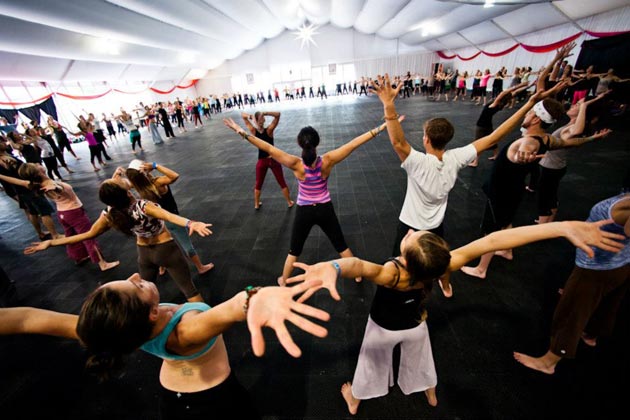Yoga classes labeled “All Levels” have their pluses and minuses for both teachers and students.
Personally, I tilt toward the plus side as I believe such classes have attracted more new yogis to the practice than otherwise. For many, it’s just easier on the ego to waltz into an “All Levels” class than to subject oneself to Newbie-ville, or plop a mat between Handstand rock stars in an upper level class.
But as both teacher and student, I’ve learned that an “All Levels” class can, at times, be tough to navigate. Where do I go with this pose? What variation do I take with that pose? It can be tricky, yes, but with a few guidelines to keep you on course, it’s not impossible. Here’s how to happily fit your mat into an “All Levels” class.
1. Shine on, but please don’t blind everyone else.
Not long ago, I took a variation of Twisted Chair Pose in an “All Levels” class and got scolded, out loud, and in front of several yogis around me, as I moved into Side Crow. Huh? I felt I was taking a variation of a pose that remained well within the class sequence.
Maybe I was crossing the arbitrary yogi line, maybe not, but the teacher made me feel as though I was disrupting, or, in other words, blinding, the students around me by busting out an advanced pose.
My inner light dimmed in a hurry. By the end of class, I felt like a heap of ashes burned at the stake. But I learned a valuable lesson: it’s important to carefully consider whether a variation of a pose is appropriate for that particular class.
What’s the general level of the students in this particular class? Is the teacher encouraging students in class to take variations, or is the teacher suggesting you stay put? Consider these questions, and, if after taking class you feel you need more freedom to explore a pose, find another teacher already. I did!
2. Listen closely, to both the teacher and your inner guide.
My “All Levels” classes have drawn stiff-as-a-brick former weightlifters who wince when the fingers reach past the knees to ballerinas who smile with their forehead resting on their shins—both of whom flowed happily through class.
But clearly, not every pose is appropriate for every body. I do my best to offer modifications to ease up on a pose, and variations to go deeper, but it’s up to the individual student to listen to what’s going on inside. And sometimes that means nixing the pose and my instructions altogether and taking a rest in Child’s Pose, for example.
3. Not all “All Levels” classes are created equal.
As teachers, we teach as close to the class description as we can, but this can vary depending on who shows up on any given day. If 95 percent of the students are still learning the fundamentals of Downward-Facing Dog, I’m naturally going to dial it back a bit—Handstands are probably not a good idea.
Likewise, if the majority of students are 7-days-a-week regulars Jones-ing for some advanced variations, the practice will reflect that. So try a few “All Levels” classes, at different times of day, and at different studios, to see where your individual level fits best.
4. Do NOT compare yourself.
Seriously. Just as I mentioned above, few “All Levels” classes are alike, and comparing your practice to the Handstand rock star next to you is just a bad idea, and another way to let the ego win. And to really work on quieting the ego, try taking a Beginner’s class if you’re newer to the practice.
Regardless of individual level, going back to review the fundamentals from time to time is always a healthy way to continue on this amazing lifelong practice. Namaste!


